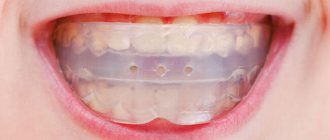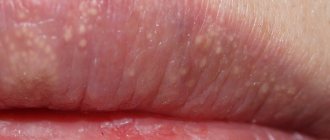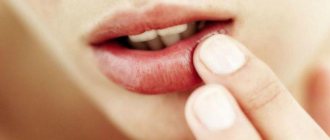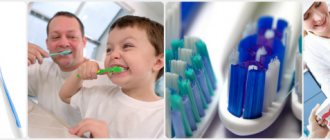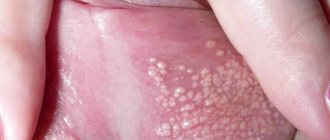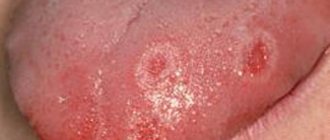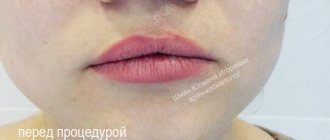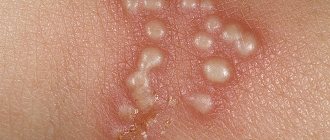Symptoms and signs
The early stages of the disease have virtually no dangerous signs. The child’s health remains normal, and skin changes have not yet appeared. The condition worsens as the area of the affected skin gradually increases.
The bubbles themselves have a number of distinctive features - lethargy, easy to open, sagging skin under the liquid inside the bubble. Primary rashes are always localized in the mouth and mucous membranes of the lips. There are no painful sensations. Opened blisters form skin crusts or wet eczema, which take a long time to heal.
Gradually the affected area increases. Infection with bacteria leads to the appearance of suppuration and foci of inflammation, in place of which eczema and large erosions subsequently appear. Another distinctive feature is the lack of healing of the skin at the site of the blister rupture. Gradually, the erosions expand and unite into a single lesion.
All forms of pemphigus have a wave-like manifestation of symptoms. In the absence of a timely response, intoxication syndrome begins - nausea and headaches. Ultimately, the death of the little patient inevitably occurs. Viral pemphigus in children has symptoms similar to the true disease, and there is a pronounced viral infection.
When to see a doctor
Baby rash appears frequently and rarely poses a real threat to the child's life. Basically it becomes a reactive feature to allergens and infections. It is important for parents to know which rashes pose a mortal danger to the child. If signs of such a rash appear, you should seek help from a dermatologist.
The pediatric department of JSC "Medicine" (clinic of academician Roitberg) has been guarding children's health for many years. You can make an appointment with a dermatovenerologist by phone. The clinic has a convenient location, a two-minute walk from the Mayakovskaya metro station, as well as the possibility of placement in a hospital for examination and treatment.
Causes of occurrence and development
The pathology begins its development after the development of autoimmune antibodies aggressive to desmoglein proteins. These proteins act as an adhesive base used to connect skin cells. In the process of protein destruction, the skin is destroyed. At this point, bacteria from the environment begin to penetrate the skin layers, causing the formation of blisters.
The factors that trigger the pathological process still remain unclear. Some of them are established by science:
- genetic predisposition to autoimmune processes;
- malfunctions of the central nervous system;
- the presence of viruses, infections or other pathogens in the body - a connection has been identified between infection with endogenous bacteria and the appearance of an autoimmune reaction.
Russian official medicine identifies the following reasons causing an inadequate immune response:
- taking medications of the thiol group - strong antibiotics, immunomodulators and others;
- burns;
- herpes virus types 1, 2 and 8;
- tactile contact with pesticides;
- severe stress or nervous overload.
It is almost impossible to establish the true cause of the disease. In fact, in laboratory conditions only the presence of aggressive antibodies is determined.
Diagnostics
This pathology is rare, and pediatricians, as a rule, cannot determine it accurately. Therefore, the primary stage of diagnosis is the distinction between pemphigus and other dermatological diseases that are accompanied by rashes of blisters and blisters.
Differential diagnosis is carried out using a special method - Nikolsky's test. The essence of the test is to rub the skin near the bubble and on a distant area of the skin, as well as pressing the fingertip on the bubble. A positive result is considered to be the presence of signs of skin separation:
- spreading of serous fluid into adjacent layers of skin when pressed;
- slight peeling of the skin in the form of a ribbon when you gently pull the skin over the bubble - similar to a sunburn;
- friction on a healthy area shows the mixing of the upper layers of the epidermis.
One of the most informative diagnostic methods is a blood test for the presence of aggressive antibodies to the desmoglein protein. If these antibodies are present, a diagnosis of pemphigus is made.
Additionally, the following may be assigned:
- cytological studies of serous fluid samples from the bottom of the erosion or from the bladder;
- general blood and urine analysis;
- chest x-ray;
- consultations with related doctors - nephrologist, cardiologist, infectious disease specialist.
Prevention and prognosis
Medicine has not proposed any specific measures to prevent pemphigus due to the fact that the true causes of its occurrence have not been established. A set of preventive measures is aimed at strengthening the health of a little person:
- formation of strong immunity;
- hardening and walking in the fresh air from the moment of birth;
- proper nutrition;
- avoidance of excessive use of drugs and medications.
Forecasts depend on the speed of contacting a doctor - for symptoms of pemphigus in children, treatment should begin as early as possible. Therefore, you should not self-medicate under any circumstances. In order not to miss the appearance of signs of pathology, it is necessary to examine any skin problems with a dermatologist.
The prognosis of true pemphigus is a priori conditionally unfavorable. Even with adequate and timely treatment, the likelihood of death cannot be eliminated. Any form of pathology is considered chronic.
At the same time, the introduction of hormonal drugs into therapy made it possible to reduce the mortality rate from 65% to 7%. The disease requires constant maintenance therapy. Otherwise, 91% of cases experience acute exacerbations and sudden progression, and consequently an increase in the likelihood of death.

